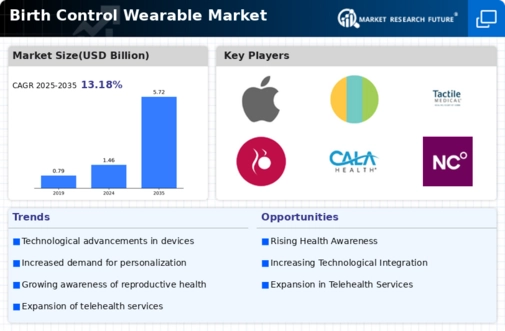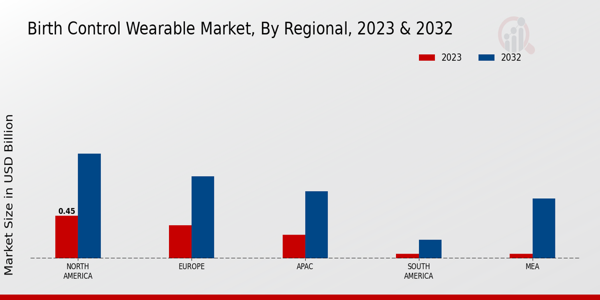Market Growth Projections
The Global Birth Control Wearable Market Industry is projected to experience substantial growth over the next decade. With an estimated market value of 1.46 USD Billion in 2024, it is expected to reach 5.72 USD Billion by 2035. This growth trajectory indicates a compound annual growth rate of 13.21% from 2025 to 2035. Such projections highlight the increasing acceptance and integration of wearable technology in reproductive health management. The anticipated growth reflects a broader trend towards personalized health solutions and the ongoing evolution of consumer preferences in the realm of family planning.
Technological Advancements
The Global Birth Control Wearable Market Industry is experiencing rapid technological advancements, which enhance the effectiveness and user experience of these devices. Innovations in sensor technology and data analytics allow for more accurate tracking of fertility cycles and ovulation periods. For instance, wearables that integrate with mobile applications provide real-time feedback and personalized insights. This technological evolution is likely to attract a broader demographic, particularly among tech-savvy individuals. As a result, the market is projected to grow from 1.46 USD Billion in 2024 to 5.72 USD Billion by 2035, reflecting a compound annual growth rate of 13.21% from 2025 to 2035.
Evolving Consumer Preferences
Evolving consumer preferences are significantly impacting the Global Birth Control Wearable Market Industry. Today's consumers are increasingly inclined towards personalized and data-driven solutions for their health needs. This trend is evident in the rising popularity of wearables that offer tailored insights into fertility and reproductive health. As individuals seek more control over their reproductive choices, the demand for innovative birth control wearables is likely to increase. This shift in consumer behavior suggests a promising future for the market, as manufacturers adapt to meet the changing expectations of their clientele.
Government Support and Initiatives
Government support and initiatives play a crucial role in shaping the Global Birth Control Wearable Market Industry. Many countries are implementing policies that promote reproductive health and access to family planning resources. This includes funding for research and development of innovative contraceptive technologies, including wearables. Such initiatives not only enhance the availability of these products but also encourage public acceptance. As governments prioritize reproductive health, the market is likely to benefit from increased investment and resources, fostering an environment conducive to growth and innovation in the sector.
Rising Demand for Non-Invasive Solutions
The Global Birth Control Wearable Market Industry is witnessing a rising demand for non-invasive contraceptive solutions. Many individuals prefer alternatives to traditional hormonal methods due to concerns about side effects and long-term health implications. Wearable devices that monitor fertility and ovulation cycles provide a non-invasive option that appeals to a growing segment of the population. This shift in consumer preference is likely to drive market growth, as more individuals seek out natural and technology-driven methods for family planning. The increasing acceptance of such solutions may further enhance the market's potential in the coming years.
Increased Awareness of Reproductive Health
There is a growing awareness of reproductive health issues globally, which significantly influences the Global Birth Control Wearable Market Industry. Educational campaigns and initiatives by health organizations are promoting the importance of family planning and reproductive rights. This heightened awareness encourages individuals to seek out effective birth control methods, including wearables. As more people understand the benefits of tracking their reproductive health, the demand for these devices is likely to rise. This trend is expected to contribute to the market's expansion, as consumers increasingly prioritize informed choices regarding their reproductive health.























